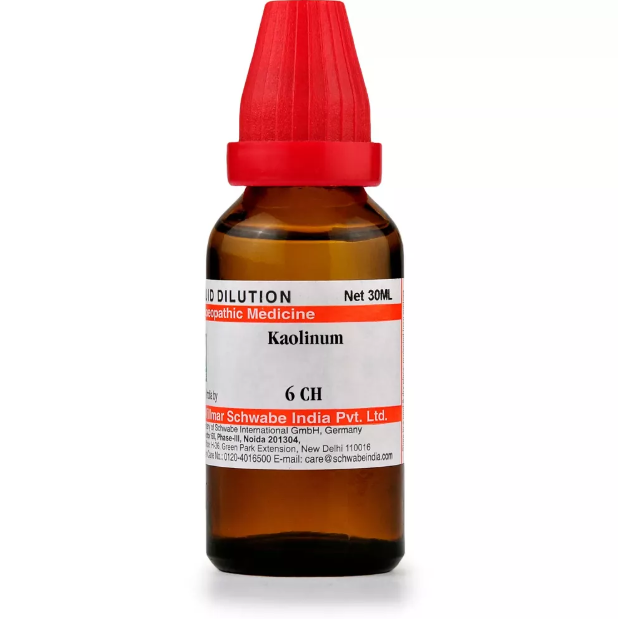ALUMINA SILICATA (Kaolinum) 6C, 12C, 30C, 200C, 1M, 10M USES AND SYMPTOMS
 ALUMINA SILICATA (KAOLINUM)
ALUMINA SILICATA (KAOLINUM)
(Andalasite Rock-Alumina 63, Silica 37 parts)
Alum-sil.
A potent remedy for persistent issues affecting the brain, spine, and nerves. Notable constriction, particularly in orifices, and venous distention are key symptoms. Weakness, especially in the spine, is prominent. The spine experiences a combination of aching and burning sensations. Limbs may encounter formication, numbness, and pain. Epileptiform convulsions and coldness during pains are also observed.
Head: Brain congestion, scalp constriction, and head pain alleviated by heat and perspiration.
Eyes: Eye pain and flickering sensations.
Nose: Frequent coryzas, nasal swelling, and ulceration (ozena). Itching, burning, yellow discharge, and a sensation of being sore, scabby, and blocked.
Respiratory: Catarrh, pain, and a raw feeling in the chest. Profound weakness sensation in the chest, stitching pains, spasmodic cough with purulent viscid expectoration. Chest soreness along the trachea, intolerant to percussion. Gray sputum, capillary bronchitis, sore larynx, and chest. Membranous croup extending to the trachea.
Extremities: Heaviness, jerking, numbness, and aching in limbs.
Skin: Formication along nerves, veins feel full and distended. Skin is sore to touch and pressure.
Modalities: Aggravated by cold air, after eating, and standing. Improved by warmth, fasting, and resting in bed.
Dose: Administer higher potencies.
SYMPTOMS OF ALUMINA SILICATA (Kaolinum)
 Head: Symptoms include congestion in the brain, scalp constriction, and head pain, which improves with heat and perspiration.
Head: Symptoms include congestion in the brain, scalp constriction, and head pain, which improves with heat and perspiration.
Eyes: Keep an eye out for eye pain and flickering sensations.
Nose: Frequent coryzas, nasal swelling, and ulceration (ozena) are common. Itching, burning, yellow discharge, and a sensation of being sore, scabby, and blocked are also observed.
Respiratory: Symptoms encompass catarrh, chest pain, and a raw feeling. There may be a profound weakness sensation in the chest, stitching pains, spasmodic cough with purulent viscid expectoration, soreness in the chest along the trachea, intolerance to percussion, gray sputum, capillary bronchitis, sore larynx, and chest. Membranous croup may extend to the trachea.
Extremities: Look out for heaviness, jerking, numbness, and aching in the limbs.
Skin: Symptoms include formication along nerves, veins feeling full and distended, and the skin being sore to touch and pressure.
Modalities: Symptoms worsen in cold air, after eating, and while standing. Improvement is observed with warmth, fasting, and resting in bed.
selection of the potency
Individualization:
- Homeopathy is based on the principle of treating the individual, not just the disease. The unique symptoms and characteristics of the person are crucial in determining the most suitable potency.
Intensity of Symptoms:
- The intensity of the symptoms guides the choice of potency. If the symptoms are intense and acute, a lower potency (e.g., 6C, 30C) might be considered. For chronic conditions with less intensity, higher potencies (e.g., 200C, 1M) may be appropriate.
Sensitivity of the Patient:
- Some individuals are more sensitive to homeopathic remedies, while others may require higher potencies. The practitioner considers the patient’s sensitivity when selecting the potency.
Acute vs. Chronic Conditions:
- Lower potencies are often used for acute conditions, while higher potencies may be considered for chronic or long-standing issues.
Previous Response to Potencies:
- The patient’s response to previous homeopathic treatments helps guide the choice of potency. If a particular potency has been effective in the past, it may be repeated or adjusted as needed.
Vital Force and Susceptibility:
- Homeopathy views illness as a disturbance in the vital force. The practitioner assesses the patient’s overall vitality and susceptibility to determine the appropriate potency.
Aggravation or Amelioration:
- The direction of the symptom response (aggravation or amelioration) after taking a remedy can influence the choice of potency.
Miasmatic Considerations:
- In classical homeopathy, the concept of miasms (inherited disease tendencies) is considered. The practitioner take this into account when selecting the potency.
Practitioner Experience:
- The experience and preference of the homeopathic practitioner play a role. Some practitioners may have success with certain potencies based on their clinical experience.
SAFETY INFORMATION
- Do not exceed the recommended dose by physician
- Keep out of the reach of children
- Store in a cool dry place away from direct sunlight
- Maintain half an hour gap between food/drink/any other medicines and homoeopathic medicine
- Avoid any strong smell in the mouth while taking medicine e.g. camphor, garlic, onion, coffee, hing
Medicine images use for reference only selection of homeopathic medicine depends on the individual’s specific symptoms and overall constitution. Moreover, homeopathy is a holistic system of medicine that treats the individual as a whole. In addition to addressing the physical symptoms, it takes into account the emotional and mental state of the person. Consequently, it’s crucial to consult with a qualified homeopathic practitioner for personalized treatment.
The information provided on this website is intended solely for educational purposes. Always seek the advice of your physician or other qualified health provider.
